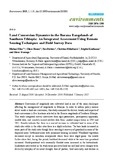| dc.contributor.author | Elias, Michael | |
| dc.contributor.author | Hensel, Oliver | |
| dc.contributor.author | Richter, Uwe | |
| dc.contributor.author | Hülsebusch, Christian | |
| dc.contributor.author | Brigitte, Kaufmann | |
| dc.contributor.author | Wasonga, Oliver | |
| dc.date.accessioned | 2015-06-09T06:47:05Z | |
| dc.date.available | 2015-06-09T06:47:05Z | |
| dc.date.issued | 2015 | |
| dc.identifier.citation | Elias, Michael;Hensel, Oliver;Richter, Uwe;Hülsebusch, Christian;Brigitte, Kaufmann;Wasonga, Oliver, Land Conversion Dynamics in the Borana Rangelands of Southern Ethiopia: An Integrated Assessment Using Remote Sensing Techniques and Field Survey Data Environments. 2015;2(1)1-31, | en_US |
| dc.identifier.uri | http://hdl.handle.net/11295/84432 | |
| dc.identifier.uri | https://doaj.org/article/fc17672c9f0f48cb91236702c3c8ebb6 | |
| dc.description.abstract | Conversion of rangelands into cultivated land is one of the main challenges affecting the management of rangelands in Ethiopia. In order to inform policy makers about trends in land-use conversion, this study examined the drivers, trends, and impacts of land conversions in five locations selected in the Borana rangelands of Southern Ethiopia. This study integrated survey interviews from agro-pastoralists, participatory appraisals, rainfall data, and remotely sensed satellite data from Landsat images taken in 1985 and 2011. Results indicate that there is a marked increase in cultivated land in some of the study sites while in the other sites there is a slight reduction. The bare lands increased in some parts of the study sites though there was slight recovery of grassland in some of the degraded areas. Settlement areas with permanent housing increased. Woodland vegetation decreased except on mountain escarpments where there were slight gains. The results further show that, during this period, bushland decreased while at the same time grassland increased. Shrub/grassland with seasonally flooded areas increased in the bottomlands. Inhabitants interviewed in the study areas perceived land use and land cover changes to be driven by interplay of recurrent drought, loss of pasture, food insecurity, and decline in income. Changes in policies that govern natural resources have influence the land use change in this area and the expansion of cultivation. Expansion of cultivation practices upon rangelands has resulting in significant loss of vegetation biomass and soil erosion, thereby precipitating rangeland degradation. The results provide comprehensive insights regarding the influence of internal and external drivers of land conversion that should be considered when making decisions for land use planning. | en_US |
| dc.language.iso | en | en_US |
| dc.publisher | University of Nairobi | en_US |
| dc.title | Land Conversion Dynamics in the Borana Rangelands of Southern Ethiopia: An Integrated Assessment Using Remote Sensing Techniques and Field Survey Data | en_US |
| dc.type | Article | en_US |
| dc.type.material | en | en_US |

